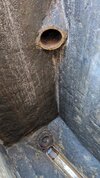Hi All
Considering re-tiling the pathway at the front of the house however before putting anything new at the surface we want to make sure whatever is below is sound so we don't have to break the new if we need to fix the old pipes later. We lifted the sanitary cover and saw the below photos.
We know that toilets and sinks run through the bottom pipe, which is about 1.5m deep. The top one we are not sure, it may be for run water since there is a rain water drain at the back of the house which we don't know where it goes.
Are those pipe old clay, those that are prone to cracking? If yes would you change them, would it be very difficult? Are there any other viable alternative than replacement such as epoxy lining?
Any pointer gratefully received. We will have a professional survey shortly but would love to have some info so I know what to walk into and ask the right questions when the guys are onsite.
Considering re-tiling the pathway at the front of the house however before putting anything new at the surface we want to make sure whatever is below is sound so we don't have to break the new if we need to fix the old pipes later. We lifted the sanitary cover and saw the below photos.
We know that toilets and sinks run through the bottom pipe, which is about 1.5m deep. The top one we are not sure, it may be for run water since there is a rain water drain at the back of the house which we don't know where it goes.
Are those pipe old clay, those that are prone to cracking? If yes would you change them, would it be very difficult? Are there any other viable alternative than replacement such as epoxy lining?
Any pointer gratefully received. We will have a professional survey shortly but would love to have some info so I know what to walk into and ask the right questions when the guys are onsite.





